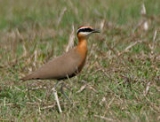
Indian Courser
Encyclopedia
The Indian Courser is a species of courser
found in mainland South Asia, mainly in the plains bounded by the Ganges and Indus river system. Like other coursers it is a ground bird found in dry open semi-desert country.
_at_bharatpur_i_img_5440.jpg) This courser is widespread in South Asia and overlaps with some other species such as the similar looking Cream-coloured Courser
This courser is widespread in South Asia and overlaps with some other species such as the similar looking Cream-coloured Courser
. This species is however brighter coloured than the Cream-coloured Courser and has a broader black eye-stripe that begins at the base of the beak. The crown is chestnut and the breast is rufous. The nape has a dark black patch where the long longer feathers forming the white stripe meet. In flight, the rump appears white and the wing tip is not as contrastingly black as in the Cream-coloured Courser. The sexes are alike.
The long legs are whitish and as in other coursers have only three forward pointing toes.
The species is closely related to other coursers in the region and are considered to form a superspecies
with Cursorius cursor, Cursorius rufus and Cursorius temminckii.
_at_bharatpur_i_img_5436.jpg) This species occurs in dry stony, scrubby or rocky country but rarely on sandy terrain from the Indus valley east short of Bangladesh and south to the tip of Peninsular India. It sometimes occurs in the dry zone of northern Sri Lanka. The wet forest zones are avoided. In southern India, the drier zone on the east coast, the Coromandel
This species occurs in dry stony, scrubby or rocky country but rarely on sandy terrain from the Indus valley east short of Bangladesh and south to the tip of Peninsular India. It sometimes occurs in the dry zone of northern Sri Lanka. The wet forest zones are avoided. In southern India, the drier zone on the east coast, the Coromandel
region, where it is not uncommon gives it the species name. It is also found patchily distributed in other parts of the peninsula. Other areas where they are commonly seen include the Deccan plateau and the desert region of northwestern India in Rajasthan. It is resident in some areas but makes local movements.
They breed mainly from March to August. Records exist from mid May in southern India and Sri Lanka and mid April in Darbhanga. A breeding record in Deccan from December is known. They nest in a scrape on bare stony ground laying 2 or 3 speckled and well-camouflaged eggs that are very spherical. The chicks are protectively coloured and on alarm crouch and remain immobile making them extremely difficult to spot. Adults do not call or display when the nest or chicks are approached. The chicks are able to move upon hatching but are initially fed by the parents and begin to forage on their own after a week.
Courser
The Coursers are a group of birds which together with the pratincoles make up the family Glareolidae. They have long legs, short wings and long pointed bills which curve downwards...
found in mainland South Asia, mainly in the plains bounded by the Ganges and Indus river system. Like other coursers it is a ground bird found in dry open semi-desert country.
Description
_at_bharatpur_i_img_5440.jpg)
Cream-coloured Courser
The Cream-colored Courser, Cursorius cursor, is a wader in the pratincole and courser family, Glareolidae.Although classed as waders, these are birds of dry open country, preferably semi-desert, where they typically hunt their insect prey by running on the ground.These coursers are found in...
. This species is however brighter coloured than the Cream-coloured Courser and has a broader black eye-stripe that begins at the base of the beak. The crown is chestnut and the breast is rufous. The nape has a dark black patch where the long longer feathers forming the white stripe meet. In flight, the rump appears white and the wing tip is not as contrastingly black as in the Cream-coloured Courser. The sexes are alike.
The long legs are whitish and as in other coursers have only three forward pointing toes.
The species is closely related to other coursers in the region and are considered to form a superspecies
Superspecies
A superspecies is a group of at least two more or less distinctive species with approximately parapatric distributions. Not all species complexes, whether cryptices or ring species are superspecies, and vice versa, but many are...
with Cursorius cursor, Cursorius rufus and Cursorius temminckii.
Distribution and habitat
_at_bharatpur_i_img_5436.jpg)
Coromandel Coast
The Coromandel Coast is the name given to the southeastern coast of the Indian Subcontinent between Cape Comorin and False Divi Point...
region, where it is not uncommon gives it the species name. It is also found patchily distributed in other parts of the peninsula. Other areas where they are commonly seen include the Deccan plateau and the desert region of northwestern India in Rajasthan. It is resident in some areas but makes local movements.
Behaviour and ecology
These birds are usually seen in small flocks. They feed on insects mainly beetles, crickets and grasshoppers picked up from the ground in stubbly or uncultivated fields. They run in spurts on the ground but take to flight with a hoarse creaky gwaat call. The flight is strong with rapid wing beats. They fly low and begin to run after landing.They breed mainly from March to August. Records exist from mid May in southern India and Sri Lanka and mid April in Darbhanga. A breeding record in Deccan from December is known. They nest in a scrape on bare stony ground laying 2 or 3 speckled and well-camouflaged eggs that are very spherical. The chicks are protectively coloured and on alarm crouch and remain immobile making them extremely difficult to spot. Adults do not call or display when the nest or chicks are approached. The chicks are able to move upon hatching but are initially fed by the parents and begin to forage on their own after a week.

